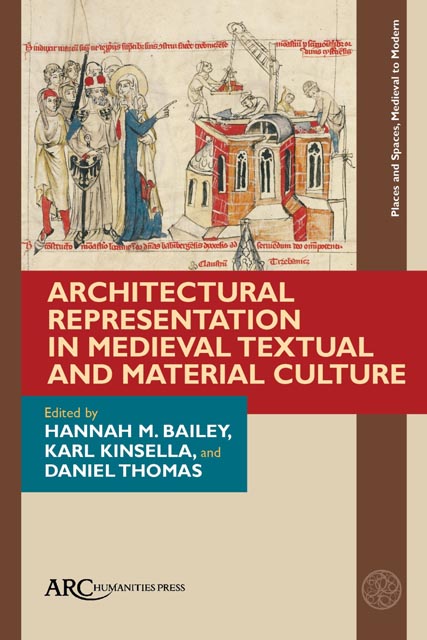Book contents
- Frontmatter
- Contents
- List of Illustrations
- Acknowledgements
- Introduction: Architectural Representation in Medieval Textual and Material Culture
- Chapter 1 Designing the Regensburg Spire and Harburg Tabernacle: The Geometries of Two Great German Gothic Drawings
- Chapter 2 Wilfrid’s Restoration of the Church at York and the Permanence of Sacred Buildings in Post-Conversion Northumbria
- Chapter 3 Heaven-Roofs and Holy Altars: Envisioning a Seventh-Century English Church in Aldhelm’s Carmina Ecclesiastica 3
- Chapter 4 “Beaten Down and Built Anew”: Saint Erkenwald and Old St. Paul’s
- Chapter 5 Castle Viewscapes in Literature and Landscapes
- Chapter 6 Architectural Alignment in Early Medieval English Settlements: Zoning, Meaning, and Function
- Chapter 7 Underneath the Arches: Peter of Eboli and the Orderly Architecture of Norman Sicily
- Chapter 8 Reading the Saint’s Church: A Northern Perspective
- Select Bibliography
- Index
Introduction: Architectural Representation in Medieval Textual and Material Culture
Published online by Cambridge University Press: 16 November 2023
- Frontmatter
- Contents
- List of Illustrations
- Acknowledgements
- Introduction: Architectural Representation in Medieval Textual and Material Culture
- Chapter 1 Designing the Regensburg Spire and Harburg Tabernacle: The Geometries of Two Great German Gothic Drawings
- Chapter 2 Wilfrid’s Restoration of the Church at York and the Permanence of Sacred Buildings in Post-Conversion Northumbria
- Chapter 3 Heaven-Roofs and Holy Altars: Envisioning a Seventh-Century English Church in Aldhelm’s Carmina Ecclesiastica 3
- Chapter 4 “Beaten Down and Built Anew”: Saint Erkenwald and Old St. Paul’s
- Chapter 5 Castle Viewscapes in Literature and Landscapes
- Chapter 6 Architectural Alignment in Early Medieval English Settlements: Zoning, Meaning, and Function
- Chapter 7 Underneath the Arches: Peter of Eboli and the Orderly Architecture of Norman Sicily
- Chapter 8 Reading the Saint’s Church: A Northern Perspective
- Select Bibliography
- Index
Summary
In the high ground in the far north of Oxfordshire, where the hills around Banbury slowly rise up toward their rim at Edge Hill with its sharp drop to Warwickshire's broad Vale of the Red Horse beyond, there lies the cluster of eight medieval churches whose seven parishes form the “Ironstone Benefice” of the Church of England—named for the principal building material which gives these churches their distinctive redbrown appearance. The present churches are predominantly fourteenth-century in date, although most incorporate earlier features stretching back to the Norman period. Each year, visitors are attracted by the combination of fine architecture and picturesque settings, together with an assortment of surviving medieval wall paintings, window glass, and carvings, and the eight churches of the Benefice are now connected in the landscape for both tourist and worshipper following the inauguration in 2015 of a 12.6-mile circular pilgrimage route.
One of the churches of the Benefice is that dedicated to the Holy Trinity at Shenington, best known today as reportedly the last parish in Britain to continue the tradition of “grass-strewing” (whereby the floor of the church is covered with fresh-cut grass for the three weeks following Whitsunday). Standing at the edge of the hilltop village, the church offers its broad south side to the sun. There on the outer wall of the south aisle, positioned between a drainpipe and a window, is a small relief carving of an ox (or possibly a bull) standing in profile with its face turned toward the viewer, and beside it a figure (apparently male) with raised hands standing inside some sort of arch or niche (Figure 1). The carving is badly weathered. The animal's hindquarters have worn away almost to nothing and the face of the standing figure has been largely obscured. In its current state it is not clear what this scene is meant to represent. It may be incomplete, beyond the simple effect of weathering, and the irregular shape of the ironstone block, which disrupts the otherwise regular ashlar-faced wall, hints at a subtly awkward effort of spoliation, or reuse of earlier material.
Located just too high to get a good look at from ground level, the carving is nevertheless sure to arouse the interest—and, perhaps, the bafflement—of those who notice it. Such an unusual image must, it seems, represent something definite, but what?
- Type
- Chapter
- Information
- Publisher: Amsterdam University PressPrint publication year: 2023



